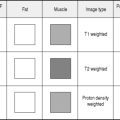Chapter 17 Breast
Methods of imaging the breast
MAMMOGRAPHY
Indications
Not indicated
Technique
Additional views may be required to provide adequate visualization of specific anatomical sites:
Compression of the breast is an integral part of mammographic imaging resulting in:
Adaptation of the technique can provide additional information:
In the presence of subpectoral implants, the push back technique of Ecklund2 can aid visualization of breast tissue.
Digital mammography
Ongoing developments of FFDM include:
1 Hancock S.L., Tucker M.A., Hoppe R.T. Breast cancer after treatment of Hodgkin’s disease. J. Natl. Cancer Inst.. 1993;85:25-31.
2 Eklund G.W., Busby R.C., Miller S.H., et al. Improved imaging of the augmented breast. Am. J. Roentgenol.. 1988;151:469-473.
3 Pisano E.D., Gatsonis C., Hendrick E., et al. Diagnostic performance of digital versus film mammography for breast cancer screening. N. Engl. J. Med.. 2005;353:1773-1783.
4 Gilbert F.J., Astley S.M., McGee M.A., et al. Single reading with computer-aided detection and double reading of screening mammograms in the United Kingdom National Breast Screening Program. Radiology. 2006;241:47-53.
James J.J. The current status of digital mammography. Clin. Radiol.. 2004;59:1-10.
NHS Breast Screening Programme. on website www.cancerscreening.nhs.uk
NICE Clinical Guidelines. (CG 41). Classification and Care of Women at Risk of Familial Breast Cancer in Primary, Secondary and Tertiary Care. October 2006. on website www.nice.org.uk
Tucker A.K., Yin Yuen Ng, editors. Textbook of Mammography. 2nd edn. Edinburgh: Churchill Livingstone; 2000:18-64.
Royal College of Radiologists, UK. The Use of Imaging in the Follow-up of Patients with Breast Cancer. Royal College of Radiologists. 3(95), 1995.
Ultrasound
Indications
Not indicated
Equipment
Hand-held, high-frequency (8–18 MHz) contact US is widely used in breast imaging, with concomitant advantages of cost, accessibility and safety. Proprietary stand off gels can be useful when assessing superficial lesions and the nipple-areolar complex.
Additional technique
Elastography2 is a non-invasive US technique, which provides a visual representation of the stiffness (elasticity) of both normal and abnormal tissue. US imaging is used to examine tissue, both before and after minimal compression. A colour coded image is generated with dark tissue representing least compressible tissue, i.e. with a higher index of suspicion of malignancy.
1 Damera A., Evans A.J., Cornford E.J., et al. Diagnosis of axillary nodal metastases by ultrasound guided core biopsy in primary operable breast cancer. Br. J. Cancer.. 2003;89:1310-1313.
2 Zhi H., Ou B., Luo B.-M., et al. Comparison of ultrasound elastography, mammography and sonography in the diagnosis of solid breast lesions. J. Ultrasound. Med.. 2007;26:807-815.
Magnetic Resonance Imaging
Indications
Indications under evaluation
Technique
1 Leach M.O., Boggis C.R., Dixon A.K., et al. Screening with magnetic resonance imaging of a UK population at high familial risk of breast cancer: a prospective multi-centre cohort study (MARIBS). Lancet. 2005;365:1769-1778.
2 Porter B.A. Current best clinical indications for breast MRI. Summary Proceedings: 29th Annual Symposium of American Society of Breast Disease. 2005. http://asbd.org/images/Porter_1.pdf.
Radionuclide Imaging
Intra-operative sentinel node identification (see p. 256)
A sentinel lymph node is the first node to which malignant cells are likely to spread from the primary tumour. The lower axillary sentinel lymph node(s) can be identified at operation following injection of a combination of radioisotope (99mTc colloidal albumin, particle size 3–80 nm) and blue dye. The subareolar route allows rapid (i.e. within minutes) uptake to lymph nodes via the plexus of Sappey.
Image-Guided Breast Biopsy





